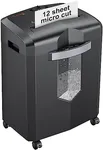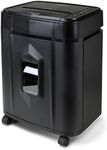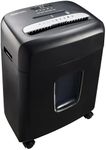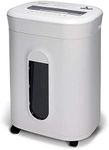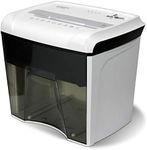Buying Guide for the Best Micro Shredders
When choosing a micro-shredder, it's important to focus on how you plan to use it and what level of security you need for your documents. Micro-shredders are designed to cut paper into very small pieces, making it much harder for anyone to reconstruct sensitive information. Think about the volume of shredding you expect to do, the types of materials you need to destroy, and how much space you have for the shredder. By understanding the key features, you can select a shredder that matches your needs for security, convenience, and efficiency.Shred Size and Security LevelShred size refers to how small the paper is cut during shredding, and this directly affects the security level. Micro-shredders typically produce tiny particles, offering a higher security level than strip-cut or cross-cut shredders. Security levels are often rated from P-1 (least secure) to P-7 (most secure). For most personal or office use, a P-4 or P-5 level is sufficient, as it turns documents into confetti-like pieces. If you handle highly confidential information, look for a higher security rating. Consider what kind of documents you need to destroy—if they contain sensitive personal or business data, opt for a finer shred size.
Sheet CapacitySheet capacity tells you how many sheets of paper the shredder can handle at once. This is important for efficiency—higher capacity means you can shred more paper in less time. Micro-shredders usually have a lower sheet capacity than other types because they cut paper into much smaller pieces. If you only shred a few documents at a time, a lower capacity is fine. If you regularly need to shred large stacks, look for a model with a higher sheet capacity to save time.
Bin SizeBin size is the amount of shredded paper the machine can hold before it needs to be emptied. A larger bin means you can shred more before stopping to empty it, which is convenient if you have a lot to shred. However, larger bins take up more space. If you only shred occasionally, a smaller bin may be sufficient. For frequent or high-volume shredding, a bigger bin will reduce interruptions.
Run Time and Cool Down TimeRun time is how long the shredder can operate continuously before it needs to cool down, while cool down time is how long you have to wait before using it again. Micro-shredders often have shorter run times because they work harder to cut paper into tiny pieces. If you only shred a few documents at a time, a short run time is fine. If you need to shred large amounts in one go, look for a model with a longer run time and shorter cool down period.
Material CompatibilitySome micro-shredders can handle more than just paper—they may also shred staples, paper clips, credit cards, or CDs. This is useful if you want to destroy a variety of sensitive materials. If you only need to shred paper, this may not matter. But if you often need to dispose of other items, check the shredder’s compatibility to avoid jams or damage.
Noise LevelNoise level refers to how loud the shredder is during operation. If you’ll be using the shredder in a shared or quiet space, a quieter model is preferable to avoid disturbing others. If noise isn’t a concern, this may not be as important. Consider where you’ll use the shredder and how much noise you can tolerate.


